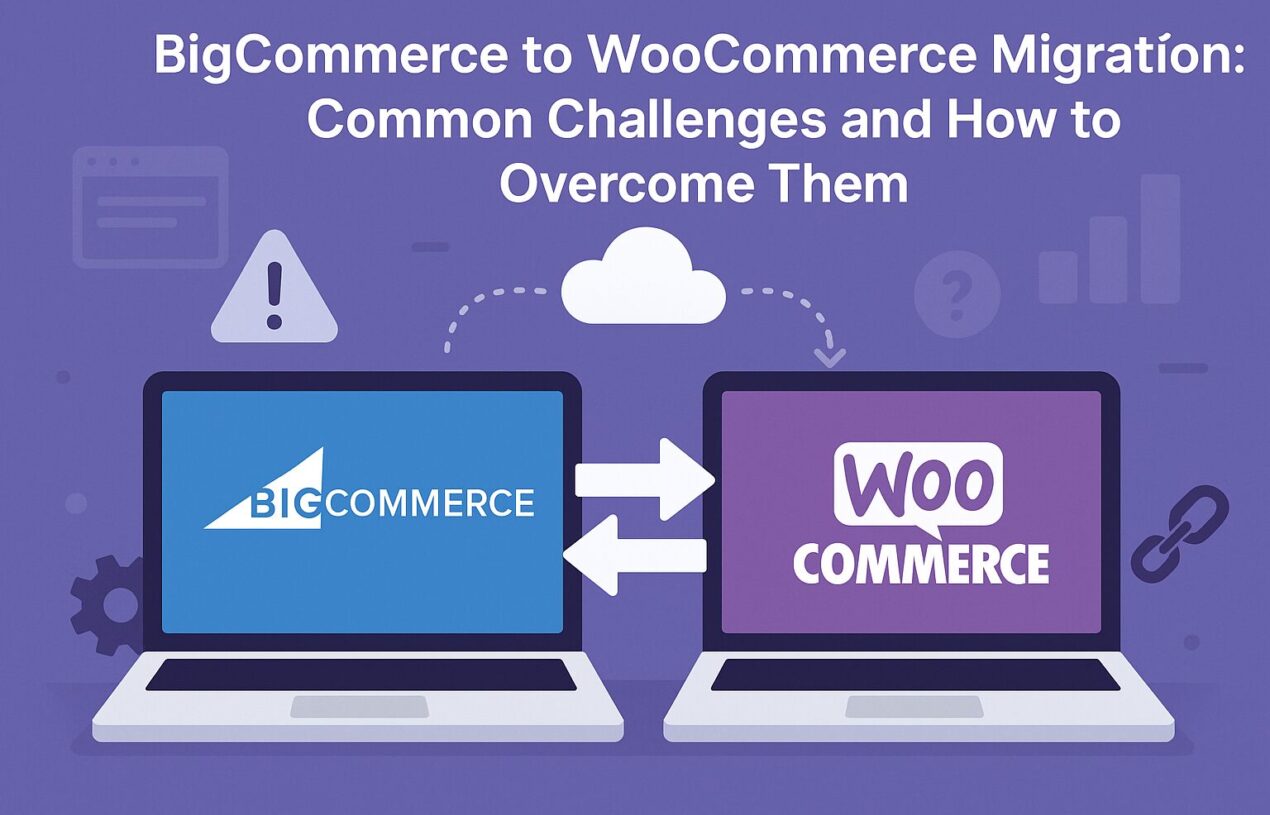Migrating from BigCommerce to WooCommerce to increase control, customisation options, and cost-effectiveness is quite a hectic task; many store owners are switching to WooCommerce.
Built on WordPress, WooCommerce can control the functionality, design, and SEO of your store because it’s an open-source, adaptable e-commerce platform that gives you unmatched handling.
When you migrate from one platform to another, it is also a challenging task. The migration process can be very stressful due to problems with data transfer and theme incompatibilities.
We’ll explain the typical obstacles to a BigCommerce to WooCommerce migration in this blog and demonstrate how to successfully get past them.
Why Convert to WooCommerce from BigCommerce?
Let’s review the reasons why companies decide to import BigCommerce to WooCommerce before getting into the difficulties:
Lower ongoing costs: WooCommerce has a wide selection of free and premium plugins.
Greater flexibility: WooCommerce offers customization options through themes and plugins.
Full data ownership: With WooCommerce, your data is stored on your own server.
SEO benefits: WordPress + WooCommerce is known for superior SEO capabilities.
1. Data Migration Inconsistencies
Challenge: It’s very common, errors can occur when transferring a lot of data, including orders, customers, categories, images, products, and metadata. Data loss or inconsistencies are possible with manual migration.
The Migrate & Import BigCommerce plugin for WooCommerce is the answer. With the help of these official plugins, you can import data from BigCommerce to WooCommerce in an automated and guided manner. It accurately maps data and guarantees that orders, customer information, product variations, and images are preserved.
To prevent surprises:
- Before you begin, make a complete backup.
- First, test in a staging area.
- After the migration, examine the import logs.
2. Theme and Design Disparities
Challenge: WooCommerce does not support BigCommerce themes. You will have to manually recreate the aesthetic if your store design is highly customized.
Solution: You can pick a theme that works with WooCommerce and looks similar to your BigCommerce layout. Drag-and-drop builders and starter templates are available in many contemporary WooCommerce themes, such as Astra, Shopfront, or Flatsome.
Moreover, if you had a distinctive layout or custom branding, think about using a page builder like Elementor or hiring a developer to duplicate the look.
3. SEO and URL Structure Issues
Challenge: The URL structures used by WooCommerce and BigCommerce differ. Broken links and a decline in SEO rank can arise from changing URLs without the appropriate redirection.
Solution: Create 301 redirects from your old BigCommerce URLs to the new WooCommerce URLs after content migration. This prevents 404 errors and maintains search engine equity.
- You can make use of SEO plugins such as Rank Math.
- Yoast SEO
- Plugin for redirection
- Additionally, whenever feasible, update internal links.
- After the migration, submit your updated sitemap to Google Search Console.
4. Payment Gateway and Shipping Configuration
Challenge: It’s possible that WooCommerce does not support or have your existing BigCommerce shipping and payment gateways configured.
Solution: PayPal, Stripe, Square, and many other gateways are supported by WooCommerce. Use WooCommerce extensions to set up comparable options.
- For shipping, take advantage of WooCommerce Shipping’s integrated DHL and USPS options.
- Examine additional FedEx, UPS, or local delivery plugins.
- Remember to test transactions.
- Set up your tax preferences according to your location.
- To prevent cart abandonment, include fallback options.
5. Customer Accounts and Passwords
Challenge: Both platforms use different encryption methods for customer passwords. This may make it difficult to log in to accounts smoothly after a migration.
Solution: Tell clients to change their passwords because hashes are not transferable. Create intuitive login/reset pages with plugins like WPForms or ThemeMyLogin. Provide users with direct links in an email campaign alerting them to the update.
To promote logins, you can also provide a one-time discount code.
For easier access, enable social login options.
6. Learning Curve and Store Management
Challenge: WooCommerce is based on WordPress, which is why it requires more manual intervention than BigCommerce. There might be a learning curve for store owners who are new to WordPress.
Solution: Make use of WooCommerce’s community forums and comprehensive documentation. From setup to advanced features, the official WooCommerce website provides instructions.
Suggested educational pathways:
- Setup Guide for WooCommerce (free)
- Tutorials on WordPress 101
- YouTube videos for those who learn best visually
7. Migrating Media Files
Challenge: If you handle product photos and other media incorrectly, BigCommerce might not transfer correctly.
Solution: The Migrate & Import BigCommerce plugin accurately links images to products and automates image transfers. But make sure:
- Resolution of images
- Alt tags are crucial for search engine optimization.
- Product descriptions with broken links
Conclusion
You can transfer from BigCommerce to WooCommerce through the correct approach and resources. Although there are some challenges to overcome, such as data transfer, design, and SEO, the official Migrate & Import BigCommerce plugin easy the process significantly easier, lowering risks and saving time.
You can move your store to WooCommerce with confidence and open up new growth prospects by being ready for common pitfalls and utilizing reliable tools.
